
Pinus nigra, the Austrian pine or black pine, is a moderately variable species of pine, occurring across Southern Europe from the Iberian Peninsula to the eastern Mediterranean, on the Anatolian peninsula of Turkey, Corsica and Cyprus, as well as Crimea and in the high mountains of Northwest Africa. Black pine, located in the Banaz district of Uşak, Türkiye, is estimated to be 1000 years old and is the oldest larch in the world. It has a length of 11 meters, a diameter of 3 meters and a circumference of 9.60 meters.

Acacia aneura, commonly known as mulga or true mulga, is a shrub or small tree native to arid outback areas of Australia. It is the dominant tree in the habitat to which it gives its name (mulga) that occurs across much of inland Australia. Specific regions have been designated the Western Australian mulga shrublands in Western Australia and Mulga Lands in Queensland.
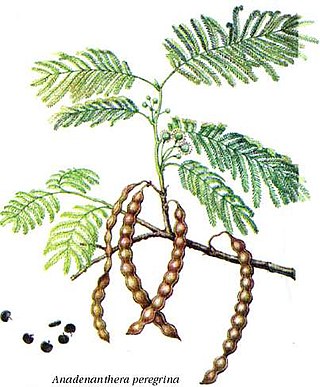
Anadenanthera peregrina, also known as yopo, jopo, cohoba, parica or calcium tree, is a perennial tree of the genus Anadenanthera native to the Caribbean and South America. It grows up to 20 m (66 ft) tall, and has a thorny bark. Its flowers grow in small, pale yellow to white spherical clusters resembling Acacia inflorescences. It is an entheogen which has been used in healing ceremonies and rituals for thousands of years in northern South America and the Caribbean. Although the seeds of the yopo tree were originally gathered from the wild, increased competition between tribes over access to the seeds led to it being intentionally cultivated and transported elsewhere, expanding the plant's distribution through introduction to areas beyond its native range.

Bufotenin is a tryptamine derivative, more specifically, a DMT analog, related to the neurotransmitter serotonin. It is an alkaloid found in some species of mushrooms, plants and toads, especially the skin.
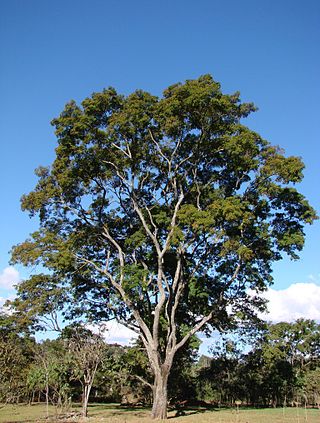
Anadenanthera colubrina is a South American tree closely related to yopo, or Anadenanthera peregrina. It grows to 5–20 m (16–66 ft) tall and the trunk is very thorny. The leaves are mimosa-like, up to 30 cm (12 in) in length and they fold up at night. In Argentina, A. colubrina produces flowers from September to December and bean pods from September to July. In Brazil A. colubrina has been given "high priority" conservation status.
Constantino Manuel Torres, known as Manuel Torres, is an archaeologist and ethnobotanist specialising in the ethnobotany of pre-columbian South America and the Caribbean. In particular, he has shed much light on the Taíno use of Anadenanthera snuff Cohoba, its paraphernalia and associated archaeology.
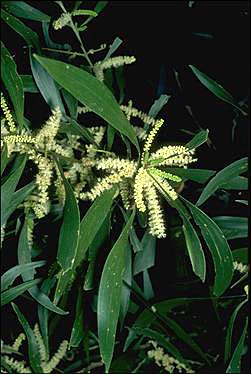
Acacia maidenii, also known as Maiden's wattle, is a tree native to Australia. It has been introduced into India and Argentina, and it grows on plantations in South Africa.

Juniperus deppeana is a small to medium-sized tree reaching 10–15 metres in height. It is native to central and northern Mexico and the southwestern United States.

Anadenanthera peregrina var. falcata is a timber tree native to Paraguay and Cerrado vegetation in Brazil, specially in Mato Grosso, Mato Grosso do Sul, Minas Gerais, and São Paulo. This plant is also used as an ornamental.
Anadenanthera colubrina var. cebil is a mimosa-like timber tree native to Caatinga and Cerrado vegetation in Argentina, Bolivia, Brazil, Paraguay and Peru. It has also been introduced to Mauritius. It grows up to 25 m (82 ft) tall, with a trunk diameter of 60–90 cm (24–35 in). The tree's mimosa-like leaves range in length from about 7–20 cm (2.8–7.9 in). The flowers are cream-colored and arrive in the spring. The seed pods are fairly straight and contain about 8 to 15 seeds each. The seeds are flat, average each about 1.5 cm (0.59 in) in diameter and have an average mass of about 0.125 g (0.0044 oz) each. The tree's wood has a density of about 840 kg/m3 (1,420 lb/cu yd).

Piptadenia is a genus of tropical shrubs and trees of the family Fabaceae. It includes 28 species native to the tropical Americas, ranging from central Mexico to southern Brazil and northwestern Argentina.

Acacia complanata, known as long-pod wattle and flat-stemmed wattle, is a perennial tree native to eastern Australia.

Vachellia seyal, the red acacia, known also as the shittah tree, is a thorny, 6– to 10-m-high tree with a pale greenish or reddish bark. At the base of the 3–10 cm (1.2–3.9 in) feathery leaves, two straight, light grey thorns grow to 7–20 cm (2.8–7.9 in) long. The blossoms are displayed in round, bright yellow clusters about 1.5 cm (0.59 in) diameter.

Parapiptadenia rigida is a perennial shrub or tree. It is not a threatened species. It is native to Argentina, Brazil, Paraguay and Uruguay. Common names include angico, angico-cedro, angico-do-banhado, angico-dos-montes, angico-verdadeiro, angico-vermelho , guarucaia and paric.
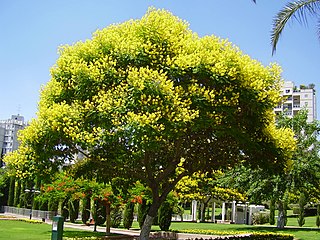
Peltophorum dubium is a tree in the family Fabaceae and subfamily Caesalpinioideae. This species is known as the Ibirá-pitá in Argentina and Paraguay, árbol de Artigas in Uruguay, and Cambuí in Brazil. It is a large tree, growing around 20–25 meters, with a more or less straight trunk.
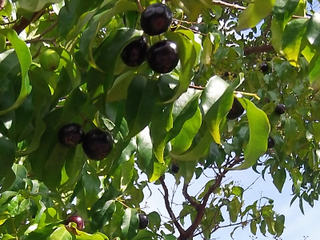
Eugenia candolleana, or rainforest plum, is a tree native from Atlantic rainforest of Brazil, known locally by the Portuguese names cambuí roxo or murtinha. It is quite rare in the wild, and has seen limited use in landscaping for its bright green foliage and purple-black fruits.
Ormosia nobilis is a tree-forming plant species in the genus Ormosia. It grows in tropical South America, primarily in Bolivia, Brazil, Colombia, French Guiana, Guyana, Peru, Paraguay, and Venezuela. The Ormosis nobilis tree is known as "sirari" and it produces a commercial hardwood which is also known as sirari.
Colubrina greggii, commonly known as Sierra nakedwood or Gregg's colubrina, is a species of flowering plant in the family Rhamnaceae native to eastern Mexico, with a disjunct population in southern Texas in the United States.
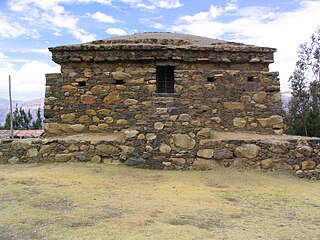
Wilcahuaín, Willcahuaín, or Huilcahuaín is an archaeological site in Peru. It is located near the village of Paria, 7 km northwest of the city of Huaraz, Ancash; at an elevation of 3,400 m (11,200 ft).

Cerradão is a type of dry forest found in Brazil, associated with the cerrado savanna ecoregion.















